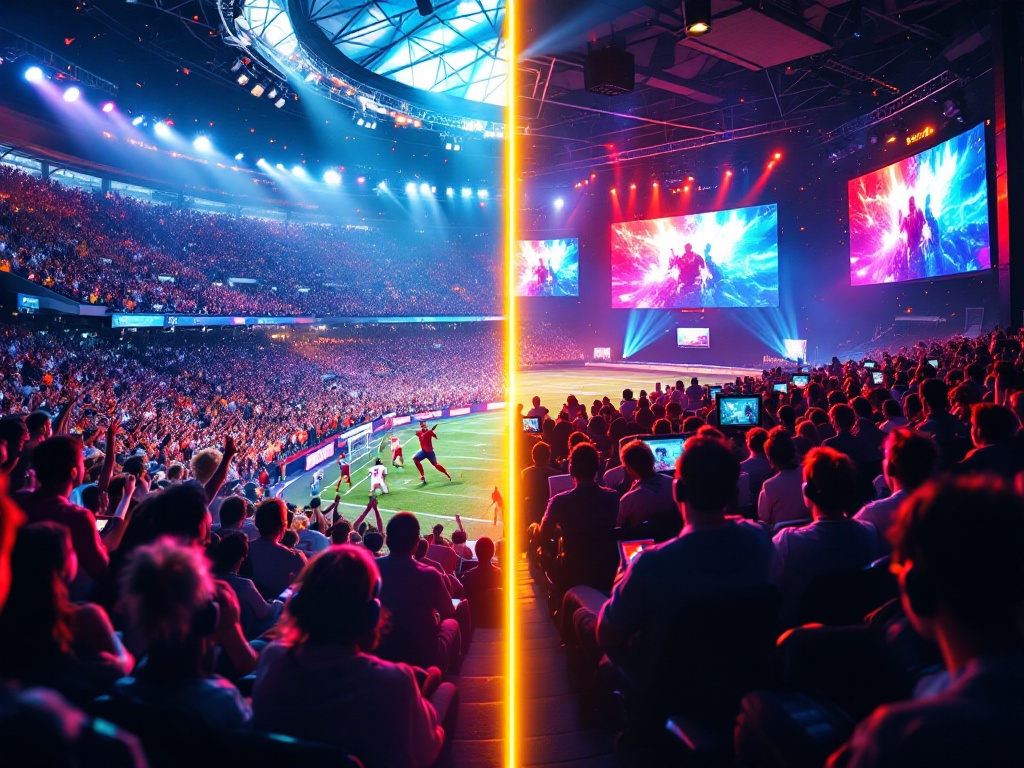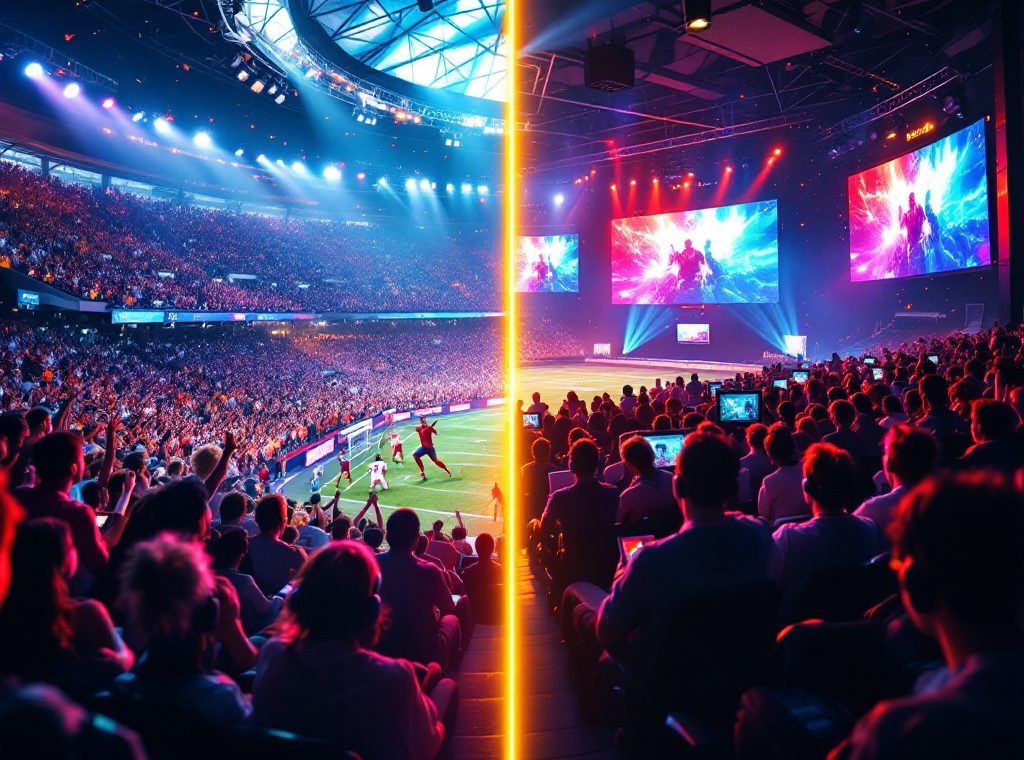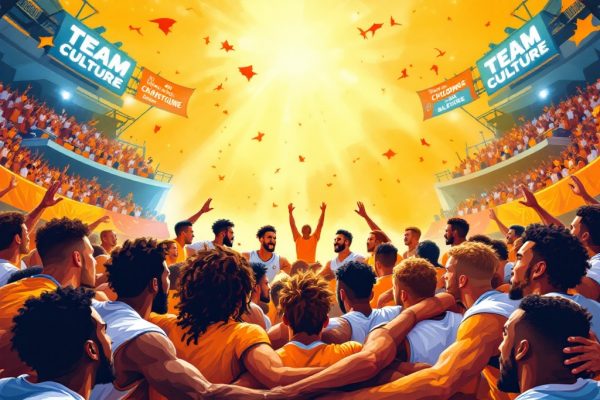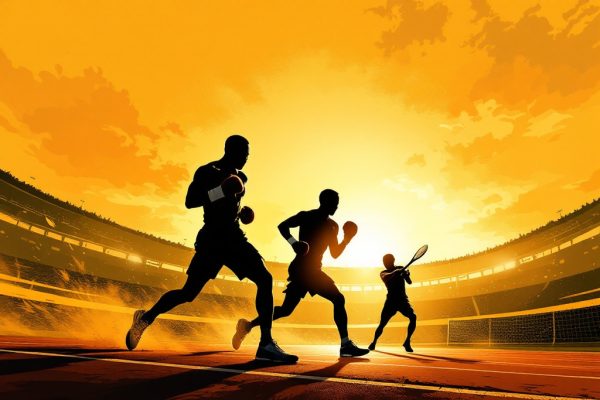Traditional Sports and Esports: The Comparison
Dive into the thrilling world of competitive gaming and traditional sports! This article explores the key differences and surprising similarities between esports and physical sports, from training regimens and skill development to fan engagement and revenue streams. Discover how esports is rapidly gaining global recognition, challenging traditional sports’ cultural dominance. Explore the future of competition and see how these two worlds are colliding and evolving. Click to learn more!
Important information

- Traditional sports emphasize physical skills and athleticism, often involving specialized equipment and established rules enforced by referees. They have long histories and dedicated fan bases rooted in local communities.
- Esports centers on competitive video gaming, prioritizing mental agility, strategic thinking, and fast reflexes. Anti-cheat software and moderators ensure fair play in the digital arena.
- Both traditional sports and esports require intense training and skill development. While physical conditioning is key for traditional athletes, esports players focus on strategy, hand-eye coordination, and quick decision-making.
- Esports is rapidly gaining mainstream acceptance, attracting large audiences, sponsorships, and media attention, while traditional sports hold established cultural significance and often inspire national pride.
- Both industries generate revenue through diverse streams. Traditional sports rely on ticket sales, merchandise, and broadcasting rights, whereas esports utilizes in-game purchases, streaming subscriptions, and sponsorships.
Understanding Traditional Sports and Esports
Traditional Sports
Traditional sports, such as football, basketball, and soccer, involve physical exertion and are played on designated fields or courts. They boast long histories and established rules, emphasizing physical prowess as the key to victory.
Esports
Esports center around competitive video gaming, demanding strategic thinking and lightning-fast reflexes within digital arenas or online platforms. Victory is achieved through established rules, but the focus is on digital skill and strategic mastery.
Defining Traditional Sports and Esports
Traditional sports, such as basketball, soccer, or tennis, are physical activities with established rules, often played in designated locations. They emphasize physical prowess and demand athleticism from participants.
Fan engagement in traditional sports often involves attending live matches, creating a vibrant atmosphere in stadiums and arenas.
Dedication and rigorous training are essential for athletes to excel, constantly striving for improvement amidst fierce competition.
Esports center on competitive video gaming, demanding skill, strategy, and rapid reflexes. Popular titles include League of Legends, Dota 2, and Counter-Strike.
Esports prioritize mental acuity and technical skills. Players must master complex game mechanics and make quick decisions under pressure.
Esports fans typically engage by watching online streams, creating large online communities and fostering a different kind of spectator experience.
Similar to traditional athletes, esports players dedicate themselves to intense training regimens to hone their skills and stay competitive.
Rules and Governance
Fair play is crucial in traditional sports. Referees and umpires ensure fairness by upholding the rules. Traditional sports grapple with issues like doping. Ultimately, they strive for competitive integrity, a goal actively pursued by governing bodies.
Fair play is also essential in esports. Anti-cheat software plays a key role in maintaining fairness by preventing cheating. Esports faces its own governance challenges, particularly concerning cheating. Similar to traditional sports, esports aims for competitive integrity, actively pursued by its governing bodies.
Rules Adherence in Traditional Sports and Esports
Fair play is essential in traditional sports. Referees and umpires enforce the rules on the field, penalizing infractions like fouls and offsides. This direct oversight helps maintain competitive integrity.
Fair play is equally crucial in esports, though achieved differently. Anti-cheat software and moderators play key roles, detecting prohibited actions such as hacking and scripting. This digital vigilance ensures a level playing field for all competitors.
Role of Referees, Umpires, and Anti-Cheat Software
In traditional sports, referees monitor gameplay for rule infractions, making real-time decisions to ensure fair play. For example, a referee might penalize a basketball player for traveling.
Referees rely on their judgment and interpretation of the rules to maintain competitive integrity within the game.
Esports utilizes anti-cheat software to detect prohibited programs or modifications that grant players an unfair advantage. For instance, this software could detect an aimbot in a first-person shooter.
This technology-driven approach aims to uphold fair competition by constantly evolving to address new challenges and exploits.
While their methods differ, both traditional sports officiating and esports anti-cheat systems share the same fundamental objective: preserving fair play and competitive balance.
Governance and Regulatory Challenges
The fractured governance of esports creates hurdles for event organizers and sponsors, unlike traditional sports with their established international bodies. This lack of centralized authority leads to regulatory inconsistencies, making it challenging to implement standard rules or protect players. Furthermore, this fragmented system often deters potential investors. To truly flourish, esports needs stronger structural foundations and clearer regulations. This improved framework would undoubtedly attract more investment and a wider audience. Esports needs to address the following key areas:
Governance
Establish a central governing body to oversee regulations, player rights, and event standards, ensuring consistency and fairness across the esports landscape.
Regulations
Implement clear and consistent regulations for player contracts, tournament rules, and anti-doping measures to create a level playing field and foster professionalism.
Investment
Creating a more structured and transparent environment will attract more investors, providing much-needed capital for growth and development. This will also give current investors more confidence.
Player Protection
Standardized regulations and a central authority will help protect players’ rights, ensuring fair treatment and promoting their well-being.
Equipment and Technology
Traditional sports rely on specialized equipment such as basketballs, tennis rackets, and golf clubs. Traditional athletes train their physical abilities, focusing on strength, agility, and endurance. A basketball player, for example, needs stamina to excel in the game. Moreover, success in traditional sports often requires strategic thinking to outmaneuver opponents.
Esports, conversely, depends on technology such as PCs, consoles, and peripherals like keyboards and mice. Esports players cultivate digital dexterity, honing their rapid reactions and precision. An esports player requires lightning-fast reflexes and intense focus. Just like in traditional sports, strategic thinking is crucial for victory in esports.
While the tools differ, both traditional and digital athletes use them for competition and gameplay. Though one involves physical exertion and the other demands intense focus and rapid reactions, the competitive drive remains a constant. Ultimately, whether on the field or online, victory hinges on skill and dedication.
Required Equipment for Traditional Sports
Every sport has unique equipment needs. Baseball players need bats, gloves, and balls. Basketball requires a ball and a hoop, while tennis uses rackets and balls. Beyond sport-specific items, protective gear is crucial. Helmets and pads are essential for athlete safety.
The right equipment isn’t just about protection; it significantly impacts performance. Track and field athletes, for example, depend on specialized gear like vaulting poles. Ultimately, having the correct equipment is paramount for both success and safety in any sport.
Technological Needs in Esports
Powerful gaming technology fuels the esports world. This includes high-performance computers, consoles, and essential peripherals such as keyboards, mice, and headsets, giving players a competitive edge. A fast, reliable internet connection is also crucial, eliminating lag and ensuring a smooth online experience. Specialized software plays a vital role, including game clients, anti-cheat programs, and streaming platforms. Esports broadcasts utilize dedicated equipment and software to deliver professional, high-quality live streams and productions. All these components contribute to the thriving esports ecosystem.
Skill Development and Athlete Training
Success in any sport relies on skill development. Traditional athletes prioritize physical conditioning, honing specific skills, and mastering teamwork.
While physical agility is key in traditional sports, esports requires mental agility, rapid reactions, and strategic thinking. Mental toughness, focus, and performing under pressure are crucial for both.
Esports athletes focus on strategy, mental acuity, and precise hand-eye coordination.
Both traditional and esports athletes require dedicated practice. Esports players spend hours perfecting game mechanics and analyzing opponents, while traditional athletes engage in physical training, drills, and team practice. Ultimately, reaching peak performance requires rigorous skill development.
Continuous Skill Improvement
To remain competitive, athletes in both traditional sports and esports require continuous skill development. This involves consistent practice and adherence to training regimens, as well as adapting to evolving strategies. Staying at the peak of performance necessitates a commitment to ongoing learning and improvement. Athletes must dedicate time to honing their skills through regular practice sessions and following structured training plans. Furthermore, the dynamic nature of sports and esports demands adaptability. Players need to stay informed about the latest strategies and techniques to maintain a competitive edge.
Physical vs. Mental Agility
While traditional sports prioritize physical agility, esports relies on mental acuity. Esports athletes require sharp reflexes and strategic thinking, along with crucial adaptability.
Research indicates training benefits both types of athletes, though their regimens must target specific agility needs. For instance, esports athletes might employ cognitive training.
Traditional sports demand physical prowess, emphasizing strength, speed, and endurance.
For instance, traditional athletes may use drills. Ultimately, consistent practice hones the necessary skills for both.
Team and Individual Competitions
Team Competitions
Team dynamics are crucial for success in team competitions. Effective collaboration, strong communication, and strategic coordination between players are essential.
Individual Competitions
Individual competitions prioritize personal skill and strategic thinking. The ability to perform under pressure is paramount.
Coaching and mentorship are vital in both formats, offering guidance and support while focusing on skill development. Coaches refine strategies, improve techniques, and enhance overall performance for both athletes and esports players, contributing significantly to success in both individual and team settings.
Team Dynamics and Individual Competitions
Success in team-based competitions, such as basketball or League of Legends, relies heavily on strong team dynamics. Effective communication, coordinated strategies, and mutual support among team members are crucial for achieving victory.
- Teamwork: players must collaborate effectively, capitalizing on each other’s strengths and compensating for weaknesses.
- Communication: clear and concise communication is essential for coordinating plays, making quick decisions, and adapting to changing circumstances.
- Synergy: the ability of team members to work together harmoniously, maximizing their collective potential, is often the key to winning.
In contrast, individual games like tennis or StarCraft II emphasize self-reliance and individual skill. Players must hone their abilities, develop effective strategies, and maintain mental fortitude to overcome their opponents.
- Individual Skill: mastery of the game’s mechanics, precise execution, and strategic thinking are paramount.
- Mental Fortitude: the ability to stay focused under pressure, manage emotions, and adapt to unexpected situations is crucial.
- Self-Reliance: players must take full responsibility for their performance, making independent decisions and executing their strategies effectively.
Both team-based and individual competitions are prominent in traditional sports and esports, significantly influencing training regimens, strategic approaches, and overall gameplay. Whether relying on teammates or solely on individual prowess, the pursuit of victory in competitive gaming demands dedication, skill, and strategic thinking.
Coaching and Mentorship
Coaching plays a vital role in achieving success in both traditional sports and esports. It significantly improves players’ skills and strategic thinking, ultimately leading to enhanced performance. Coaches dedicate their time to meticulously analyzing opponents, enabling them to develop effective game plans and personalized training programs tailored to each player’s needs.
Mentorship provided by coaches creates a supportive environment that fosters both personal and professional growth. This supportive atmosphere helps players effectively manage stress and other challenges they may encounter.
Esports coaching often focuses on game-specific strategies and in-game communication, crucial elements for success in the digital arena. Traditional sports coaches, conversely, place a strong emphasis on physical conditioning, teamwork, and sportsmanship, essential components of performance in physical sports.
Despite these differences, both coaching styles share the fundamental goal of maximizing player potential. By providing guidance, support, and tailored training, coaches in both traditional sports and esports aim to help players reach their full potential and achieve competitive success.
Audience Demographics and Global Reach
Traditional sports enthusiasts come from diverse backgrounds and age groups. Esports fans, however, tend to be younger, digitally savvy, and immersed in gaming culture. This younger demographic is the driving force behind esports’ rapid global expansion and shapes its distinct cultural influence.
While traditional sports boast large, established fan bases often rooted in local or national pride, esports transcends geographical boundaries. Its digital nature fosters international competition and allows fans worldwide to connect, creating a truly global community.
Traditional Sports vs. Esports Audience
Traditional sports fans, across all ages, often rally behind local teams, packing stadiums and connecting via established channels like TV and radio. They maintain massive global followings, especially for major events like the Olympics or World Cup.
Esports fans tend to be younger, globally dispersed, and tech-savvy, engaging primarily online through streaming platforms, social media, and gaming sites. Esports viewership is growing rapidly, particularly among younger demographics.
Despite their differences, both groups share a fervent passion for their chosen sports.
Demographic Appeal and Global Presence
Esports cultivates a vast, global community, embracing a diverse international fanbase and transcending cultural barriers.
Traditional sports, conversely, often maintain strong cultural ties, influencing their popularity within specific regions. Baseball’s widespread appeal in America, compared to its niche following elsewhere, illustrates this cultural impact.
Fan Engagement and Community Interaction
Traditional Sports
Traditional sports create shared experiences, uniting fans in stadiums and arenas to cultivate local communities and fan clubs. They rely on TV and radio for broadcasting, focusing on local engagement.
Esports
Esports connects a global community online through platforms like Twitch and YouTube, utilizing chat features and social media. This digital environment allows fans to directly interact with players, participating in live stream chats and online discussions. Esports leverages online streaming and social media for global reach, forging new connections with fans.
Traditional Sports Event Experience
There’s something special about experiencing live sports. Being there with fellow fans, sharing the thrill of the game, creates a powerful sense of community. This in-person connection strengthens the bond between fans and their teams, forging lasting memories. The electric energy of the crowd elevates the competition, making it an unparalleled form of entertainment, unlike any other.
Esports Community and Interaction
Esports communities thrive online, connecting fans with players and teams through platforms like Twitch and YouTube Gaming. Viewers can watch live matches, chat with players, and participate in discussions, creating a unique connection unlike traditional sports. Organizations also use social media platforms such as Twitter and Discord to build community and share updates.
Revenue Streams and Economic Impact
Traditional Sports
Traditional sports generate revenue through various channels, including ticket sales, merchandise, sponsorships, and broadcast agreements. These established revenue streams have contributed to the substantial economic influence of traditional sports over decades, fostering large and dedicated fan bases.
Esports
Esports, a relatively young industry, utilizes different monetization strategies. These include in-game purchases, streaming subscriptions, advertising, and sponsorships. While esports’ economic impact is rapidly growing, it is still catching up to the more established traditional sports market.
Revenue Channels in Traditional Sports
Traditional sports benefit from diverse revenue streams. Ticket sales for live events remain a cornerstone of income. Broadcasting rights, highly sought after by media companies, provide another substantial revenue channel. Brand sponsorships inject significant capital into the industry. Merchandise sales, featuring popular items like jerseys and hats, further enhance revenue generation. These combined income sources underscore the considerable financial impact of traditional sports.
Revenue Sources
- live game ticket sales,
- broadcasting rights,
- brand sponsorships,
- merchandise sales.
Impact
These revenue streams contribute to the substantial financial impact of traditional sports.
Monetization in Esports
The esports industry thrives on diverse revenue streams. Media rights, sponsorships, and advertising are major contributors, alongside merchandise and ticket sales. In-game purchases and streaming subscriptions further bolster earnings. Content creation and influencer marketing provide additional income for esports organizations. This multifaceted approach positions the industry for continued growth and success.
Health and Career Span
Injuries and Health Concerns
Traditional sports often result in physical injuries such as sprains, fractures, and concussions. Esports athletes face different health risks, including carpal tunnel syndrome, eye strain, and back pain, often caused by extended screen time and repetitive movements.
Stress, Anxiety, and Lifestyle
Research, including a University of Essex study, shows that esports athletes experience similar levels of stress and anxiety as traditional athletes. A study in the “Journal of Sport and Health Science” also indicates that these players frequently experience sleep deprivation and poor nutrition.
Career Longevity
Physical limitations can shorten careers in traditional sports. However, esports careers are affected by declining reaction time and rapid technological advancements, often leading to early retirement.
Burnout and Adaptation
Burnout and the constant pressure to adapt to game updates contribute to shorter career spans in esports.
Health Risks in Traditional Sports
Traditional sports often demand physical exertion, which can increase the risk of injuries. Such injuries can be categorized into two main types: sudden injuries and overuse injuries. Sudden injuries, like sprains, fractures, and concussions, result from immediate physical impacts or movements. Overuse injuries, on the other hand, develop gradually over time due to repetitive motions and stress. These can include conditions such as osteoarthritis, tendonitis, and back pain. Such health risks can significantly impact an athlete’s career longevity and overall well-being, making awareness of these potential dangers crucial.
Health Concerns in Esports
Esports athletes often face health challenges due to demanding training. Extended screen time can strain their eyes, repetitive motions may cause carpal tunnel syndrome, and back pain is common due to poor posture during long practice sessions. This can lead to further musculoskeletal problems. Increased awareness and preventative measures can mitigate these risks. Here’s a breakdown of common issues and how to address them:
Eye Strain
- Problem: Extended screen time leads to dryness, irritation, and blurred vision.
- Solution: Use the 20-20-20 rule: every 20 minutes, look at something 20 feet away for 20 seconds. Ensure proper screen brightness and distance, and consider blue light filtering glasses.
Carpal Tunnel Syndrome
- Problem: Repetitive hand motions cause wrist pain, numbness, and tingling.
- Solution: Take frequent breaks, maintain proper wrist posture with ergonomic keyboards and mice, and perform hand stretches regularly.
Back Pain
- Problem: Poor posture and prolonged sitting contribute to backaches and stiffness.
- Solution: Invest in an ergonomic chair, take breaks to stand and stretch, and practice exercises to strengthen core muscles.
Musculoskeletal Problems
- Problem: Continued strain can lead to other issues like neck pain and tendinitis.
- Solution: Prioritize regular exercise, stretching, and maintaining a healthy lifestyle to minimize overall risk.
Career Span Comparisons
Esports professionals often enjoy longer careers than athletes in traditional sports. This is primarily due to the different demands of each field.
Physical ability is crucial in traditional sports. As an athlete’s physical prowess declines, their career often shortens. The risk of career-ending injuries is also higher in traditional sports.
In contrast, esports emphasizes mental acuity. While physical fitness is beneficial, it’s not the primary factor determining an esports player’s success. Esports players are less prone to career-ending physical injuries.
Consequently, esports athletes can maintain peak performance for a longer time, resulting in more enduring careers.
Cultural Impact and Public Perception
Traditional sports are deeply ingrained in our culture, shaping traditions and national identities. Events like the Olympics and the World Cup unite nations and ignite national pride.
While esports is a more recent phenomenon, competitive gaming is rapidly becoming mainstream, attracting massive audiences, sponsors, and media coverage. This increasing recognition solidifies esports’ cultural influence and establishes its position in modern entertainment and competitive landscapes.
Traditional Sports Cultural Significance
Traditional sports are integral to cultural identity, reflecting regional nuances and fostering community through shared experiences. They are a cornerstone of public life, shaping social interactions and traditions. Research highlights the social benefits, showing how participation improves social skills, strengthens community engagement, and cultivates cultural understanding. Consider baseball’s unique rituals in the US, cricket’s rich traditions in India, or the cultural significance of football in Brazil. These sports often inspire national pride, uniting people under a shared cultural banner.
Esports Mainstream Acceptance
Esports’ impact on society and culture is undeniable, mirroring the rise of traditional sports. Booming viewership and substantial investments, along with exploding media coverage, have propelled esports into the mainstream. Just as traditional sports once gained cultural prominence, esports are now widespread, impacting media, sponsorships, and even education, cementing their place in our culture.


















